Joint Maintenance Strategy Optimization for Railway Bogie Wheelset
Abstract
1. Introduction
2. Problem Statement
- (1)
- The wear of the wheel flange and diameter is caused by external shocks, and they are uncorrelated with each other.
- (2)
- In this study, it is assumed that the depot is not equipped to automatically measure wheelsets. The wheel flange thickness and wheel diameter are measured manually, and the measurements are recorded by maintenance personnel. The internal failures of the wheel are not considered.
- (3)
- A maintenance cycle starts at the end of the previous periodic inspection and ends at the start of the next periodic inspection, and the interval of a maintenance cycle is Δt.
- (4)
- The effect of reprofiling is imperfect. Reprofiling only recovers the wheel profile but does not eliminate the failure mechanism. After reprofiling, the condition of the wheel is between ‘repaired as new’ and ‘repaired as old’.
- (1)
- The wheelset is inspected daily to check its surface. If there is damage exceeding the limit on the tread, the wheel is reprofiled to eliminate surface damage and to recover the thickness of the flange to , where is the wheel flange thickness threshold after reprofiling.
- (2)
- The wheelset is periodically cleaned, measured and maintained. If the wheel flange thickness is greater than , normal maintenance is performed to remove defects on the flange and tread, such as burrs and sharp edges, where is the wheel flange thickness threshold to trigger preventive reprofiling. If the thickness of the flange is less than , preventive reprofiling is carried out to restore the thickness of the flange to .
- (3)
- If it is found that the wheel diameter is less than the threshold during periodic inspection, the wheel is replaced.
- (1)
- Working event o: The wheel is in normal working condition.
- (2)
- Daily inspection event x: The vehicle returns to the depot, and the wheel surfaces are inspected for damages.
- (3)
- Periodic inspection event s: The wheel is periodically cleaned, maintenance is performed and the main parameters of the wheel are measured.
- (4)
- Corrective maintenance event c: When it is found that the wheel tread damage or wear exceeds the limit during daily inspection, reprofiling is carried out to eliminate the surface damage.
- (5)
- Preventive maintenance event r: If the thickness of the wheel flange is below , reprofiling is implemented to restore the thickness of the flange to .
- (6)
- Replacement event g: When the wheel diameter reaches the use limit, the wheelset is replaced.
3. Optimization Model of the Joint Maintenance Strategy
3.1. Deterioration Model
3.2. Joint Maintenance Probability Model
3.2.1. Maintenance Probability Model
- (1)
- The probability of preventive maintenance subjected to the last preventive maintenance
- (2)
- The probability of corrective maintenance subjected to the last preventive maintenance
- (3)
- The probability of preventive maintenance subjected to the last corrective maintenance
- (4)
- The probability of corrective maintenance subjected to the last corrective maintenance
- (5)
- The probability of the wheel flange thickness exceeding the limit under the condition of the last preventive maintenance
- (6)
- The probability of the wheel flange thickness exceeding the limit under the condition of the last corrective maintenance
- (7)
- The probability of the wheel diameter exceeding the limit
3.2.2. The Risk of Wheel Flange Failure
- (1)
- Event is denoted as the m-th imperfect maintenance of the wheel at time tm, where , and it works to time iΔt, normally. Considering the relationship between maintenance time kΔt and time iΔt, the following cases are discussed.
- (2)
- Event indicates that the wheel has been reprofiled in the i1-th, i2-th,…, im-th maintenance cycle, and the wheel flange thickness exceeds SDL until time iΔt. Using equation (17), can be obtained as
- (3)
- Event is denoted as the event that occurs after the wheel is reprofiled in the i1-th, i2-th,…, im-th maintenance cycles, and in the interval (iΔt,(i + 1)Δt], the flange thickness occurs over the limit.where indicates that the k-th reprofiling is performed at time tk, and the (k − 1)-th reprofiling is implemented at time , where , k = 1, 2, …. The value of is the probability value that the wheel needs to be reprofiled, as discussed in the previous sections (1)–(4), and the specific situation corresponds to its value.
3.3. Optimization Model
4. Numerical Analysis
4.1. Parameter Setting
4.2. Numerical Results for Wheelset Maintenance
4.3. Analysis of Optimization Results
4.4. Cost Comparison
4.5. Discussion
5. Conclusions
Author Contributions
Funding
Institutional Review Board Statement
Informed Consent Statement
Conflicts of Interest
References
- Nejlaoui, M.; Houidi, A.; Affi, Z.; Romdhane, L. A hybrid multi-objective imperialist competitive algorithm and Monte Carlo method for robust safety design of a rail vehicle. C. R. Mec. 2017, 345, 712–723. [Google Scholar] [CrossRef]
- Xue, X.; Robinson, M.; Schmid, F.; Smith, R. Development issues for impact safety of rail vehicles: Robustness of crashworthy designs, effect of structural crashworthiness on passenger safety and behaviour characterization of vehicle materials. Proc. Inst. Mech. Eng. Part F J. Rail Rapid Transit 2018, 232, 461–470. [Google Scholar] [CrossRef]
- Hidirov, S.; Guler, H. Reliability, availability and maintainability analyses for railway infrastructure management. Struct. Infrastruct. Eng. 2019, 15, 1221–1233. [Google Scholar] [CrossRef]
- Eker, O.F.; Camci, F.; Guclu, A.; Yilboga, H.; Sevkli, M.; Baskan, S. A Simple state-based prognostic model for railway turnout systems. IEEE Trans. Ind. Electron. 2010, 58, 1718–1726. [Google Scholar] [CrossRef]
- Lai, J.; Xu, J.; Liao, T.; Zheng, Z.; Chen, R.; Wang, P. Investigation on train dynamic derailment in railway turnouts caused by track failure. Eng. Fail. Anal. 2022, 134, 106050. [Google Scholar] [CrossRef]
- Li, X.; Torstensson, P.T.; Nielsen, J.C.O. Simulation of vertical dynamic vehicle–track interaction in a railway crossing using Green’s functions. J. Sound Vib. 2017, 410, 318–329. [Google Scholar] [CrossRef]
- Kou, J.; Zhang, J.; Zhou, H.; Wang, C.; Sun, L. Effect of the worn status of wheel/rail profiles on wheel wear over curved tracks. J. Mech. Sci. Technol. 2021, 35, 945–954. [Google Scholar] [CrossRef]
- Smitirupa, P.; Samantaray, A.K.; Bhattacharyya, R. Prediction of railway wheel wear and its influence on the vehicle dynamics in a specific operating sector of Indian railways network. Wear Int. J. Sci. Technol. Frict. Lubr. Wear 2018, 406–407, 92–104. [Google Scholar]
- Zhao, W.J. Prediction of Metro Wheel Wear and Optimization of the Wheel Reprofiling Strategy; China Jiliang University: Hangzhou, China, 2014. [Google Scholar]
- Geng, Q.L.; Shi, Y.H.; Yin, J.; Gao, W. Fuzzy combination prediction method of IOWA operator based on forecasting effective measure. Chongqing Technol Bus. Univ. 2018, 35, 72–77. [Google Scholar]
- Fletcher, D.I.; Smith, L.; Kapoor, A. Rail rolling contact fatigue dependence on friction, predicted using fracture mechanics with a three-dimensional boundary element model. Eng. Fract. Mech. 2009, 76, 2612–2625. [Google Scholar] [CrossRef]
- de Almeida Costa, M.; de Azevedo Peixoto Braga, J.P.; Andrade, A.R. A data-driven maintenance policy for railway wheelset based on survival analysis and Markov decision process. Qual. Reliab. Eng. 2021, 37, 176–198. [Google Scholar] [CrossRef]
- Palese, J.W.; Zarembski, A.M.; Ebersole, K. Stochastic Analysis of Transit Wheel Wear and Optimized Forecasting of Wheel Maintenance Requirements. In Proceedings of the 2019 Joint Rail Conference, Sandy, UT, USA, 9–12 April 2019. [Google Scholar]
- Zeng, Y.; Song, D.; Zhang, W.; Zhou, B.; Xie, M.; Tang, X. A new physics-based data-driven guideline for wear modelling and prediction of train wheels. Wear 2020, 456–457, 203355. [Google Scholar] [CrossRef]
- Chang, M.G.; Lee, J.S. Early stage data-based probabilistic wear life prediction and maintenance interval optimization of driving wheels. Reliab. Eng. Syst. Saf. 2020, 197, 106791. [Google Scholar] [CrossRef]
- Zhu, W.; Yang, D.; Guo, Z.; Huang, J.; Huang, Y. Data-driven wheel wear modeling and reprofiling strategy optimization for metro systems. Transp. Res. Rec. J. Transp. Res. Board 2015, 2476, 67–76. [Google Scholar] [CrossRef]
- Wang, L.; Yuan, H.; Na, W.B. Optimization of the reprofiling strategy and remaining useful life prediction of wheels based on a data-driven wear model. Syst. Eng.-Theory Pract. 2011, 31, 1143–1152. [Google Scholar]
- Liu, B.; Lin, J.; Zhang, L.; Kumar, U. A dynamic prescriptive maintenance model considering system aging and degradation. IEEE Access 2019, 7, 94931–94943. [Google Scholar] [CrossRef]
- Umamaheswari, R.; Chitra, S.; Kavitha, D. Reliability analysis and dynamic maintenance model based on fuzzy degradation approach. Soft Comput. 2021, 25, 3577–3592. [Google Scholar] [CrossRef]
- Lin, J.; Pulido, J.; Asplund, M. Reliability analysis for preventive maintenance based on classical and bayesian semi-parametric degradation approaches using locomotive wheel-sets as a case study. Reliab. Eng. Syst. Saf. 2015, 134, 143–156. [Google Scholar] [CrossRef]
- Shen, R.Y.; Wang, T.T.; Luo, Q.Z. Towards prognostic and health management of train wheels in the Chinese railway industry. IEEE Access 2019, 7, 115292–115303. [Google Scholar] [CrossRef]
- Zhu, W.; Xiao, X.; Huang, Z.; Fan, W. Evaluating the wheelset health status of rail transit vehicles: Synthesis of wear mechanism and data-driven analysis. J. Transp. Eng. Part A Syst. 2020, 146, 04020139. [Google Scholar] [CrossRef]
- Kijima, M.; Nakagawa, T. Replacement policies of a shock model with imperfect preventive. Eur. J. Oper. Res. 1992, 57, 100–110. [Google Scholar] [CrossRef]
- Junca, M.; Sánchez-Silva, M. Optimal maintenance policy for a compound Poisson shock model. IEEE Trans. Reliab. 2013, 62, 66–72. [Google Scholar] [CrossRef][Green Version]
- Zhang, Z.H.; Zhai, Y.L.; Li, D.W. Performance reliability evaluation based on impact theory. Syst. Eng. Electron. 2014, 36, 2108–2112. [Google Scholar]
- Li, D.; Zhang, Z.; Zhong, Q.; Li, W. Optimal combination maintenance strategy of deteriorating complex system. Acta Aeronaut. Astronaut. Sin. 2015, 36, 872–880. [Google Scholar]
- Ranjkesh, S.H.; Hamadani, A.Z.; Mahmoodi, S. A new cumulative shock model with damage and inter-arrival time dependency. Reliab. Eng. Syst. Saf. 2019, 192, 106047. [Google Scholar] [CrossRef]
- Cao, W. An explicit compound Poisson process-based shock deterioration model for reliability assessment of aging structures. J. Traffic Transp. Eng. 2021. [Google Scholar] [CrossRef]
- Jin, C.; Ran, Y.; Wang, Z.; Huang, G.; Xiao, L.; Zhang, G. Reliability analysis of gear rotation meta-action unit based on Weibull and inverse Gaussian competing failure process. Eng. Fail. Anal. 2020, 117, 104953. [Google Scholar] [CrossRef]
- Li, Y.; Ma, X.B.; Zhao, Y. A condition-based maintenance model for a three-state system subject to degradation and environmental shocks. Comput. Ind. Eng. 2017, 105, 210–222. [Google Scholar]
- Bei, W.; Cui, L.R. Reliability analysis of periodically inspected systems with competing risks under Markovian environments. Comput. Ind. Eng. 2021, 158, 107415. [Google Scholar]
- Zhang, N.; Fouladirad, M.; Barros, A.; Zhang, J. Reliability and maintenance analysis of a degradation-threshold-shock model for a system in a dynamic environment. Appl. Math. Model. 2021, 91, 549–562. [Google Scholar] [CrossRef]
- Zhang, L.; Zhang, J. Uncertain process–based reliability and maintenance modeling for systems under mutually dependent degradation and shock processes. Qual. Reliab. Eng. Int. 2020, 37, 3638–3660. [Google Scholar] [CrossRef]
- Mingcheng, E.; Li, B.; Jiang, Z.; Li, Q. An Optimal Reprofiling policy for high-speed train wheels subject to wear and external shocks using a Semi-Markov decision process. IEEE Trans. Reliab. 2018, 67, 1468–1481. [Google Scholar] [CrossRef]
- Liang, C. A maintenance model for High-Speed Train wheel subject to internal degradation and external shocks. In Proceedings of the Prognostics and System Health Management Conference, Harbin, China, 15 May 2017. [Google Scholar]
- TB/T-449-2016; Wheel Profile for Locomotive and Car. China Railway Publishing House: Beijing, China, 2016.
- Wang, L.; Xu, H.; Yuan, H.; Zhao, W.; Chen, X. Optimizing the reprofiling strategy of metro wheels based on a data-driven wear model. Eur. J. Oper. Res. 2015, 242, 975–986. [Google Scholar] [CrossRef]
- Xu, H.; Yuan, H.; Wang, L.; Na, W.; Xu, W.; Li, Y. Modeling of metro wheel wear and optimization of the wheel Re-profiling strategy based on gaussian processes. J. Mech. Eng. 2010, 46, 88–95. [Google Scholar] [CrossRef]
- Measures for class I and II maintenance of CRH2 multiple units (Provisional).
- Zeng, Q.J. Life-span analysis of metro vehicle wheel. Electr. Locomot. Mass Transit Veh. 2005, 28, 47–49. [Google Scholar]
- Kijima, M.; Morimura, H.; Suzuki, Y. Periodic replacement problem without assuming minimal repair. Eur. J. Oper. Res. 1988, 37, 194–203. [Google Scholar] [CrossRef]
- Liao, G.L. Research on the Security State Prediction and Lathing Strategy Optimization for the Wheelset of Urban Rail Train; Beijing Jiaotong University: Beijing, China, 2014. [Google Scholar]
- Zhang, Y.; Wang, S.; Que, C.R. Economic reprofifing strategy of CRH2A EMU based on wheelset wear data. Railw. Comput. Appl. 2021, 30, 6–10. [Google Scholar]
- Zhang, J.W. Neural Network-Based High-Speed Train Wheel Set Size Prediction and Repair Strategy Research; Southwest Jiaotong University: Chengdu, China, 2017. [Google Scholar]
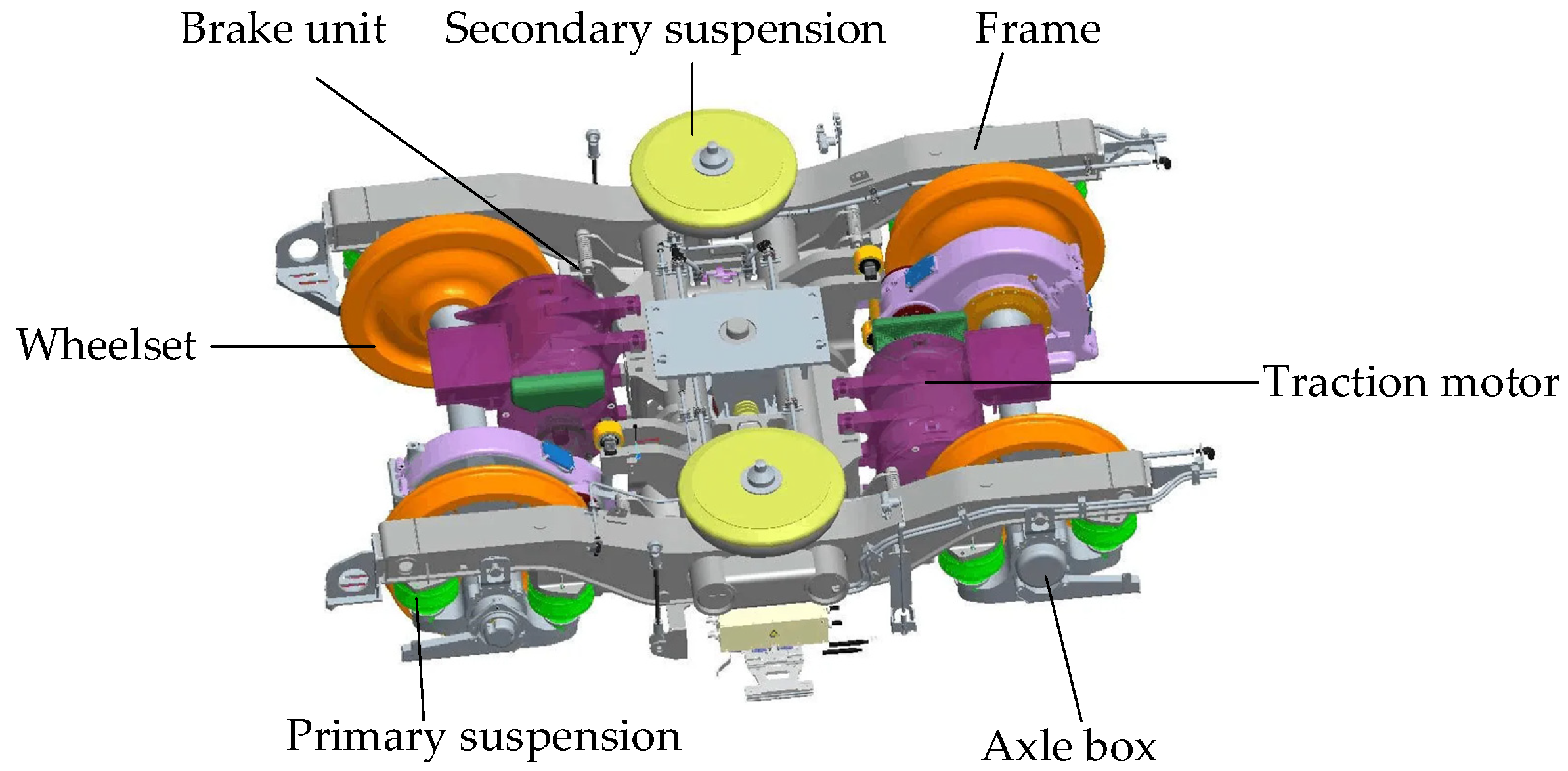
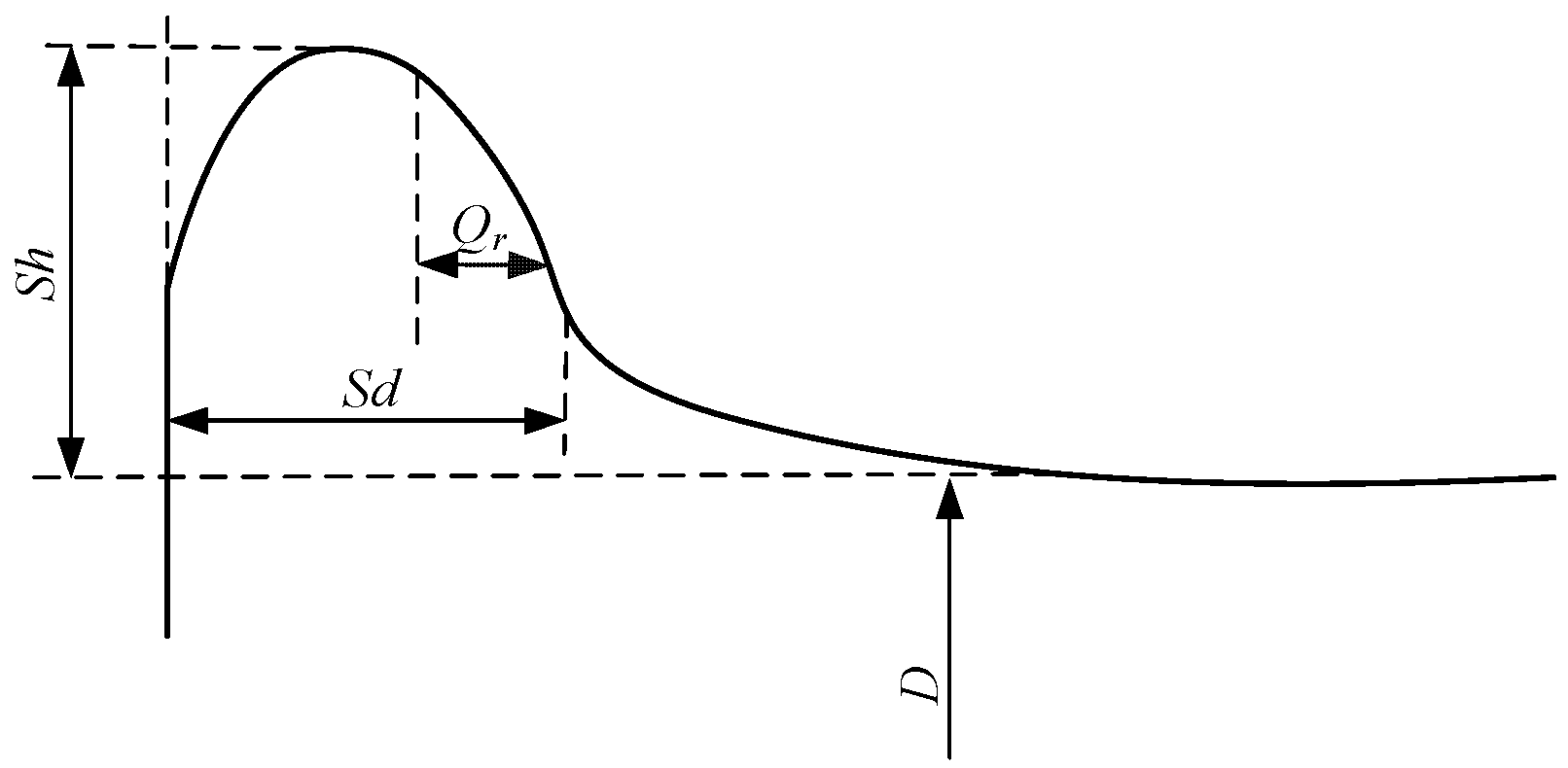


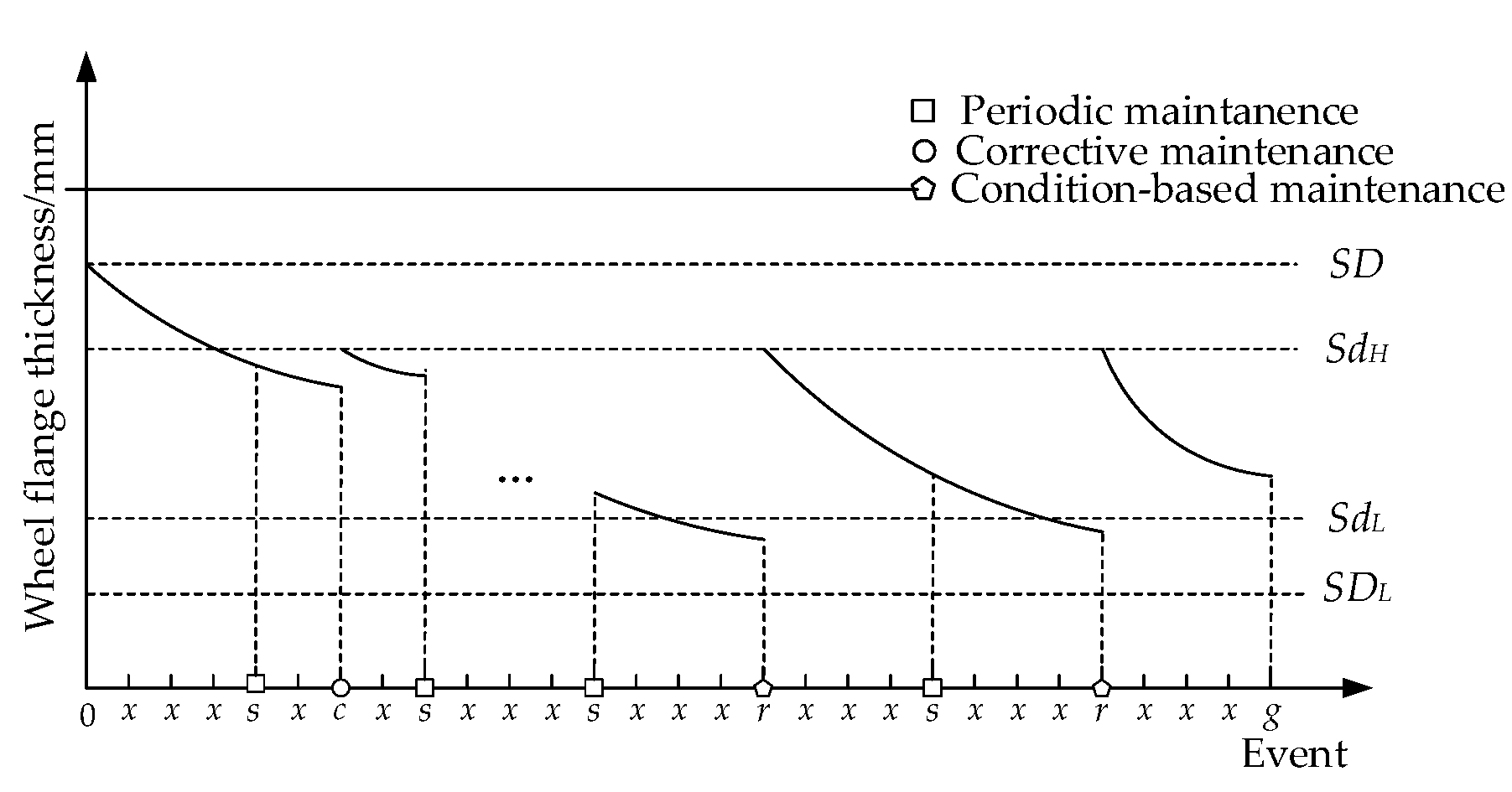
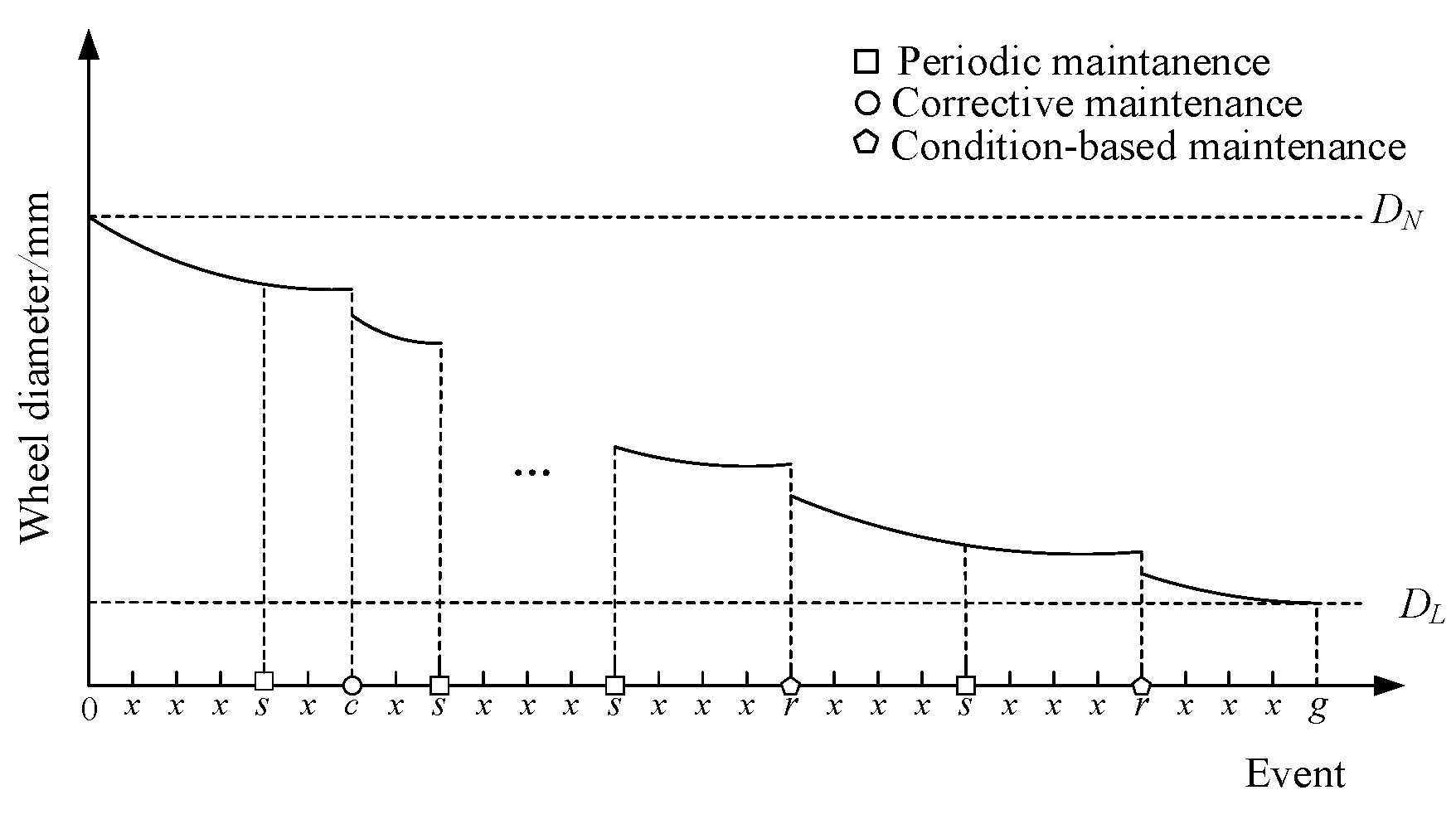
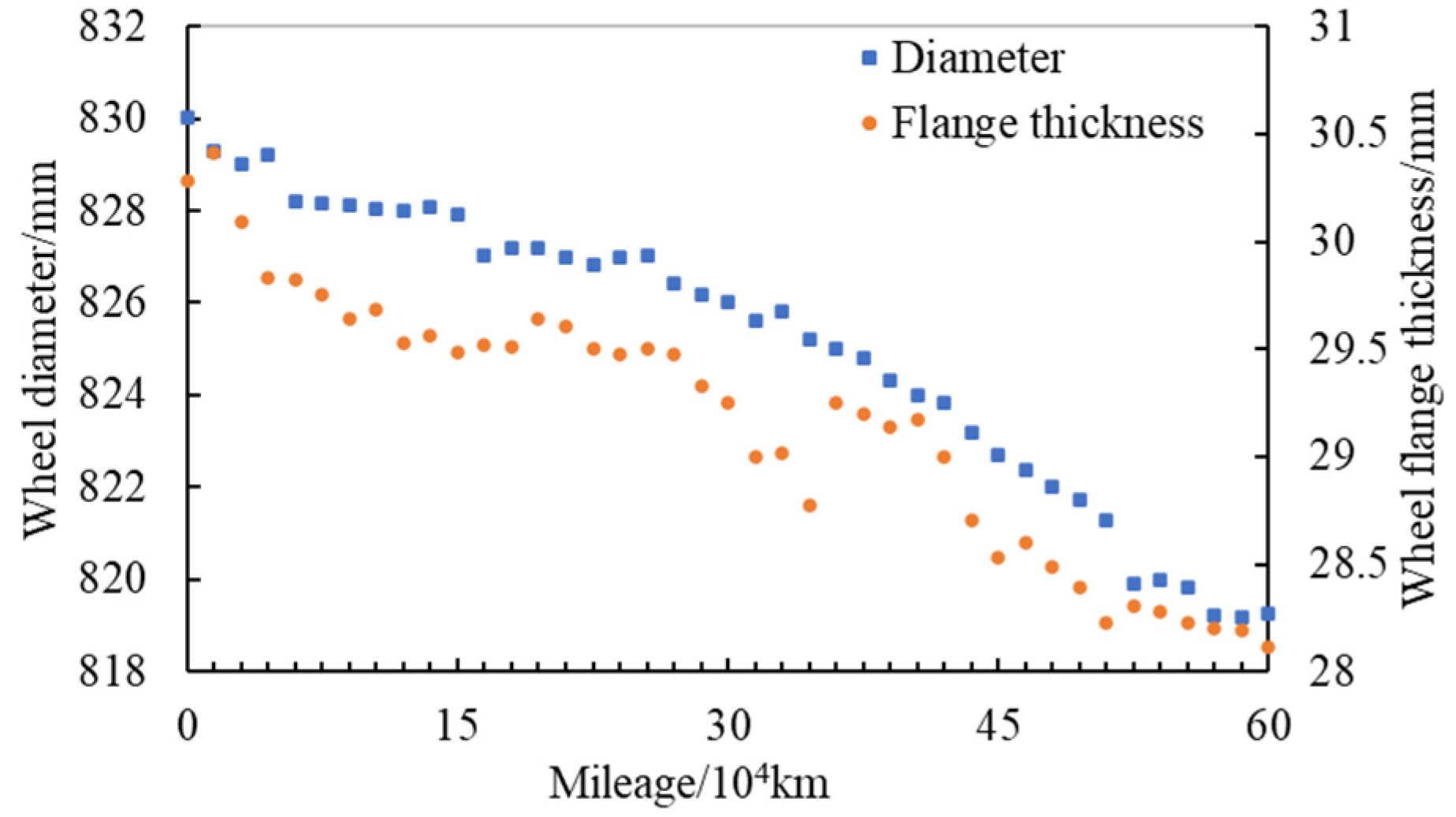
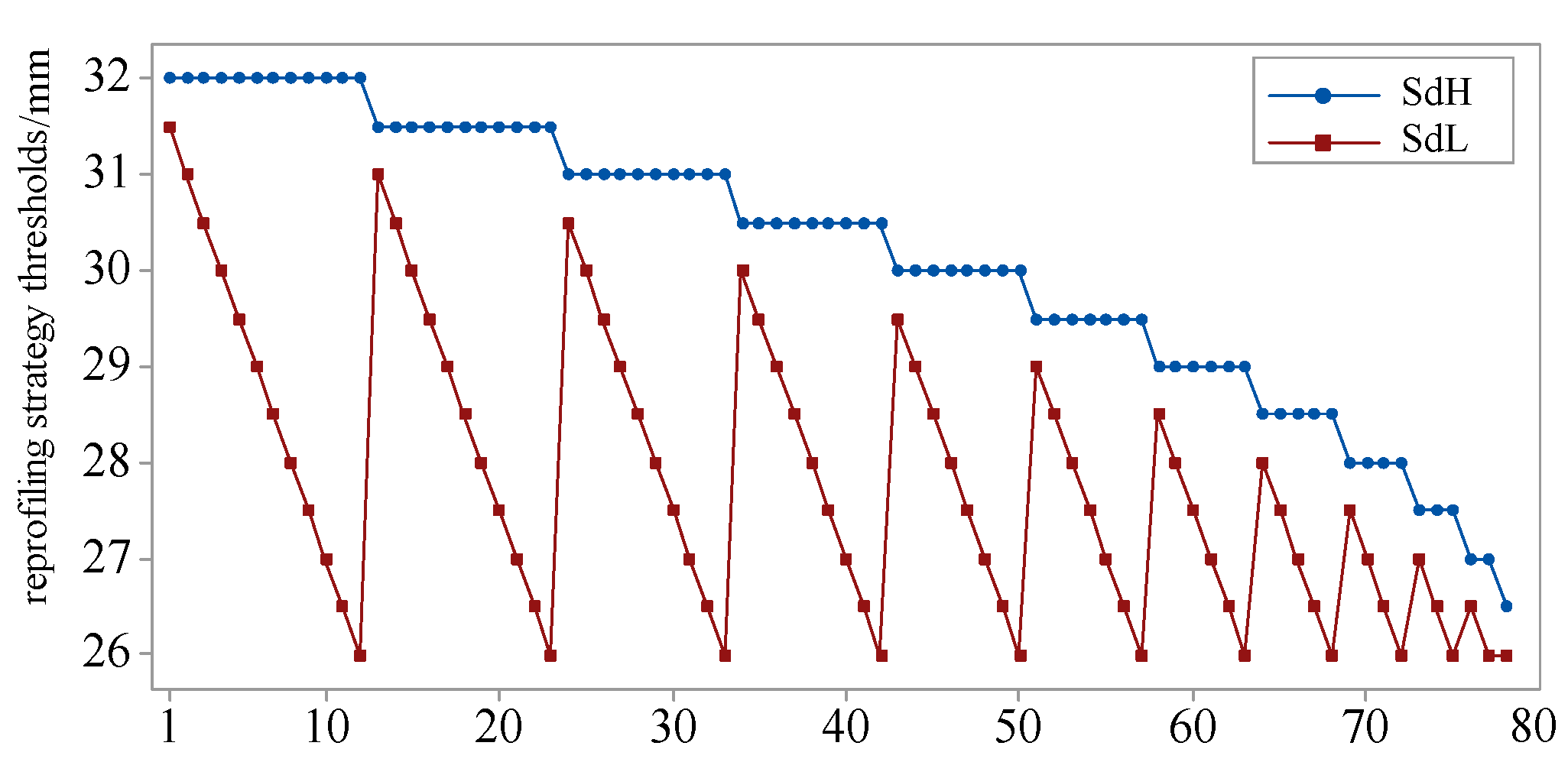
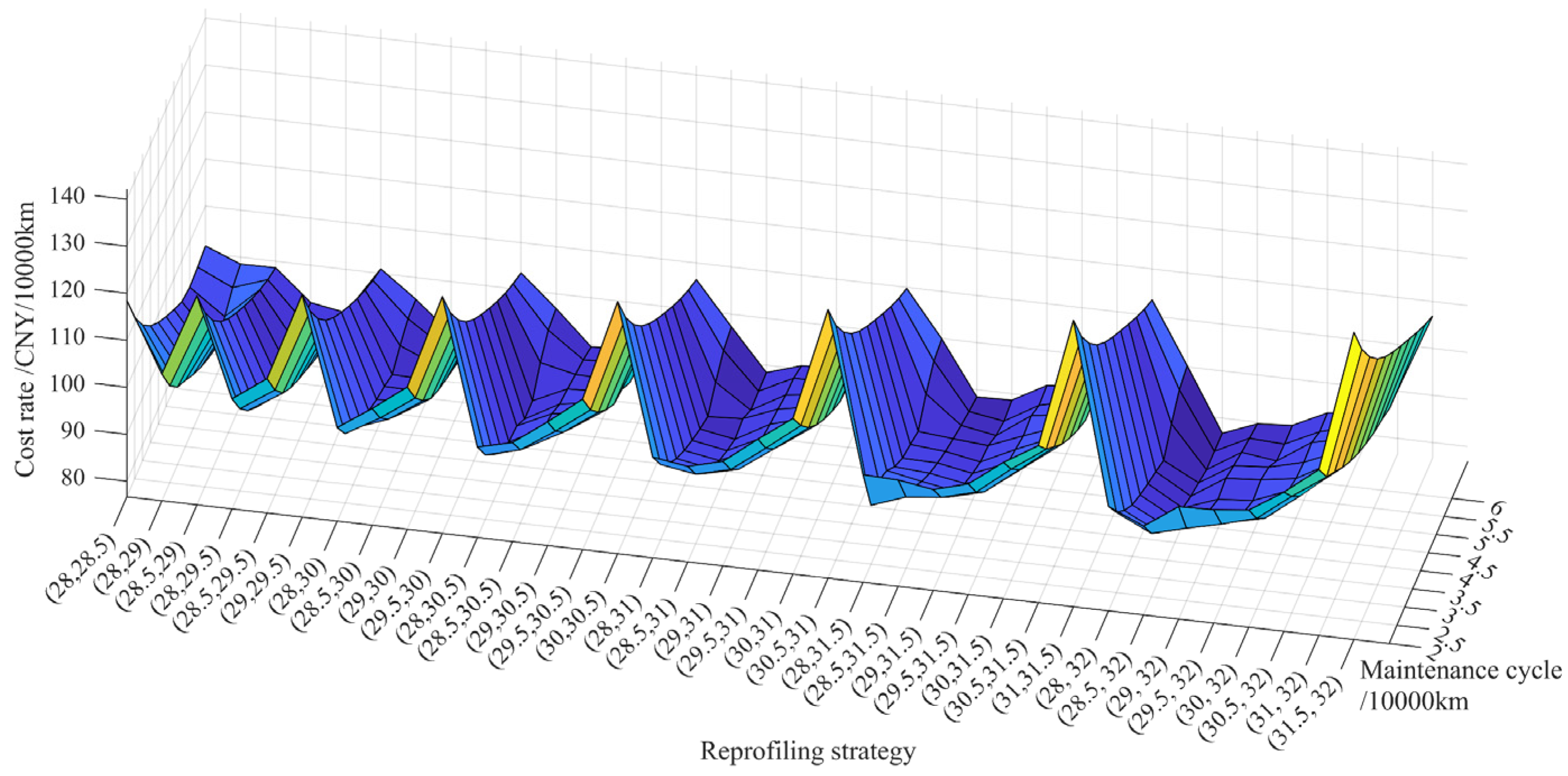
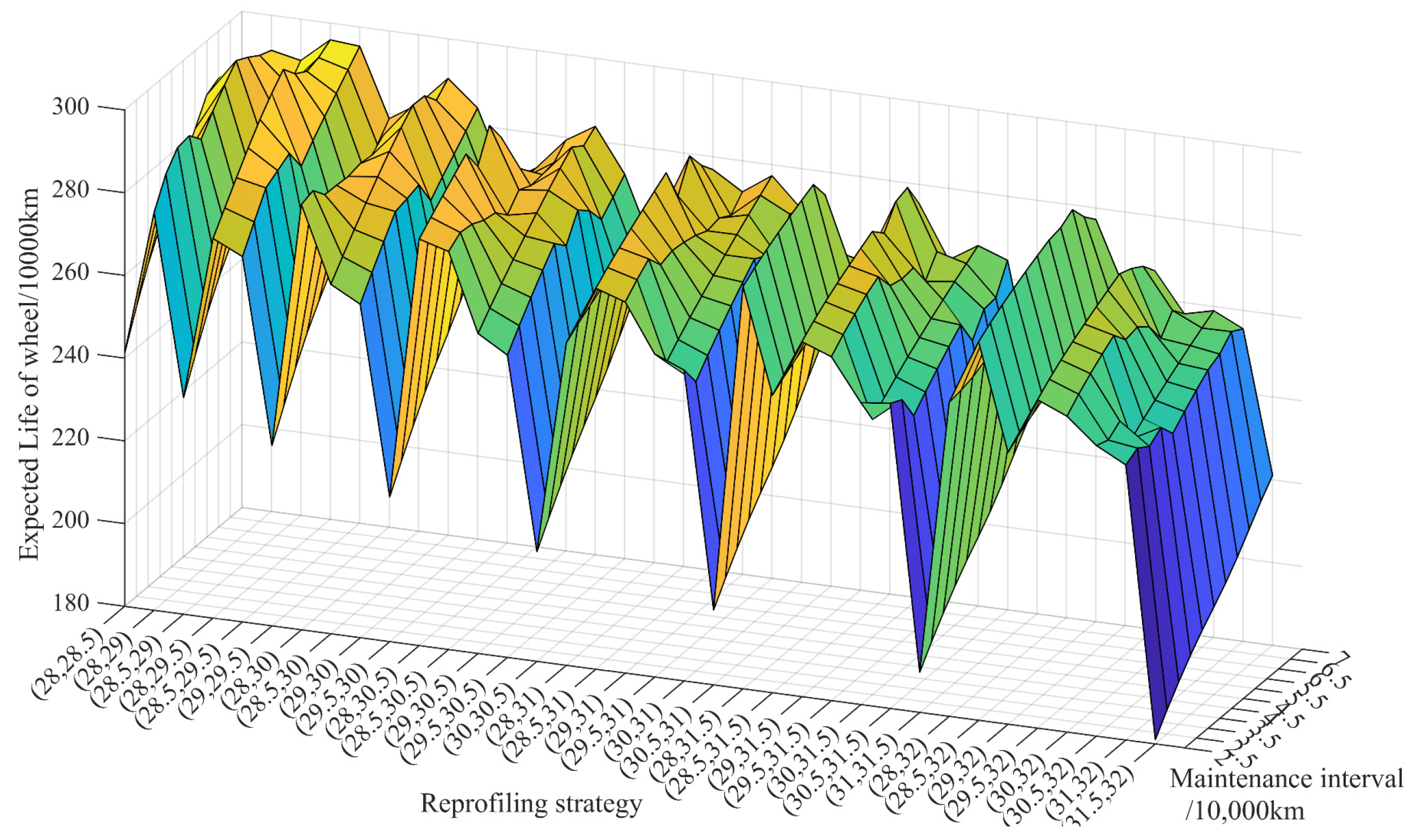
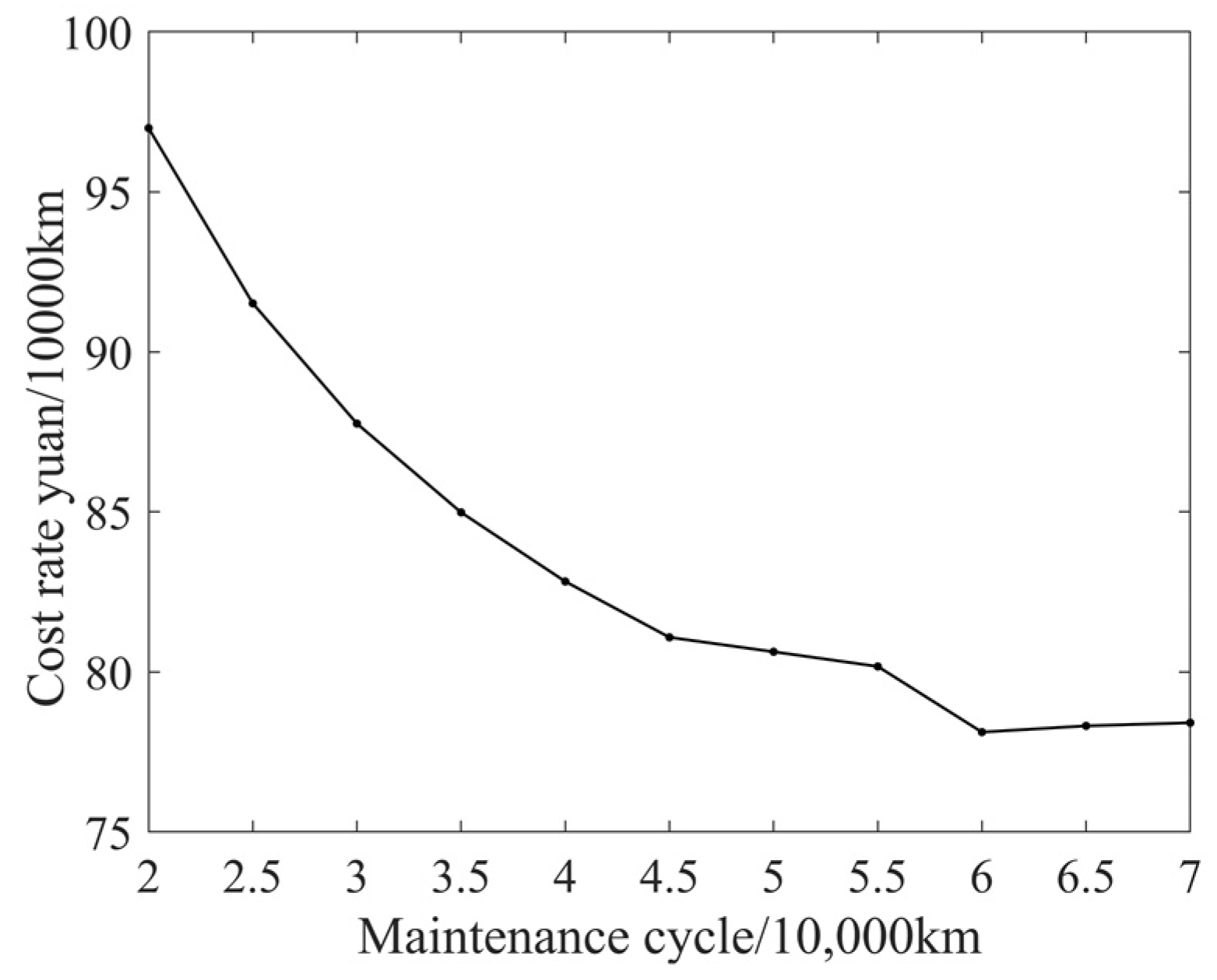

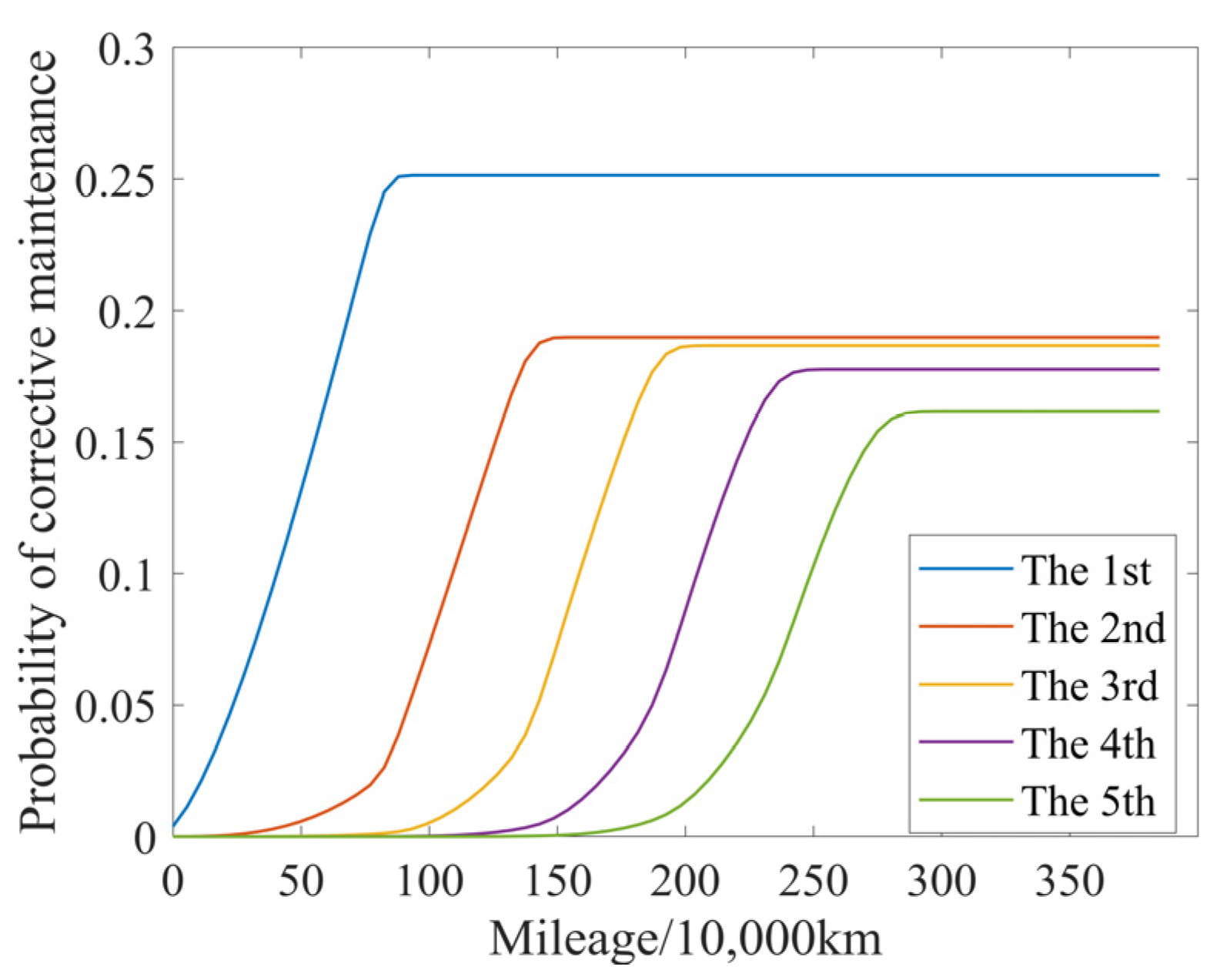

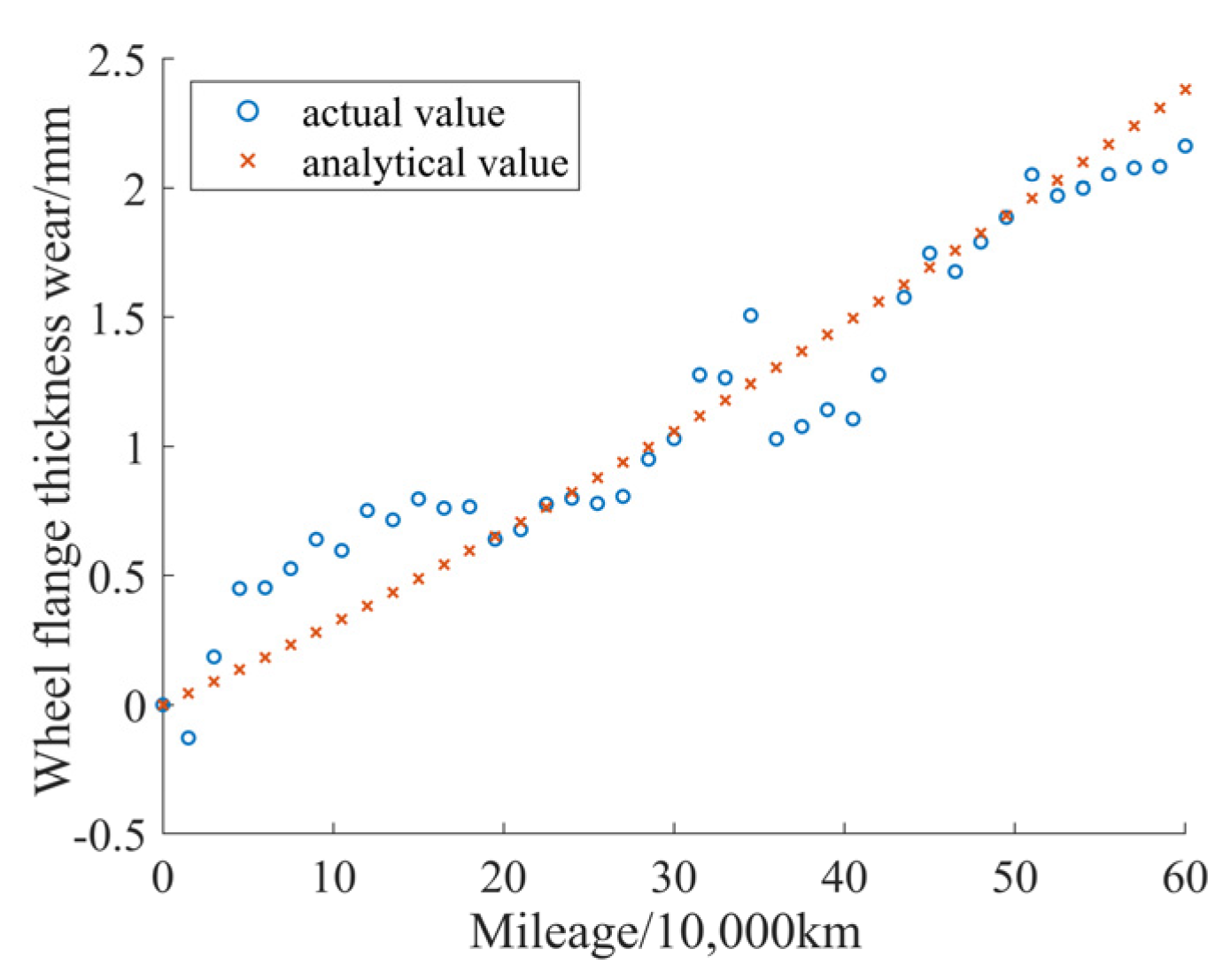
| Items | The Limit |
|---|---|
| Wheel diameter | 790~860 mm |
| Wheel flange height | 28~33 mm |
| Wheel flange thickness | 26~32 mm |
| Qr value | 6.5~12.7 mm |
| Inside distance of wheelset | 1353 (+3, −2) mm |
| The Current Maintenance Strategy | The Proposed Joint Maintenance Strategy |
|---|---|
| Reprofiling the wheel periodically | Reprofiling depending on the wheel condition |
| Reprofiling when the thickness of the flange is less than the threshold | Reprofiling when the thickness of the flange is less than |
| Reprofiling recovers the wheel to the standard profile | Reprofiling recovers the flange thickness to |
| Both of them need daily inspection, and reprofiling is carried out in time when the tread surface is a failure. The wheel is replaced when the diameter is below the usage limit. | |
| Item | Check Items | The Reprofiling Standard |
|---|---|---|
| Tread | Check the wheel tread for scratches and spalling | 1. Scratch limit: More than one scratch length ≤ 75 mm The length of more than two scratches is between 50~75 mm The length of more than four scratches is between 25~50 mm Damage depth > 0.8 mm 2. Spalling limit: One spalling length ≤ 30 mm Two spalling damage lengths ≤ 20 mm Spalling depth ≤ 1 mm |
| Items | Ci | Cm | Cp | Cc | Cl | Cr |
|---|---|---|---|---|---|---|
| The Cost Value | 20 | 50 | 400 | 1060 | 50,000 | 12,000 |
| Number | Maintenance Strategy Value | Reprofiling Times/Time | Expected Life/104 km | Cost Rate/(CNY/104 km) | ||
|---|---|---|---|---|---|---|
| Δt | SdL | SdH | ||||
| 1 | 5 | 31.5 | 32 | 14 | 204.61 | 116.02 |
| 2 | 5 | 31 | 32 | 10 | 250.23 | 94.33 |
| 3 | 5 | 30.5 | 32 | 7 | 251.40 | 89.24 |
| 4 | 5 | 30 | 32 | 6 | 263.64 | 85.12 |
| 5 | 5 | 29.5 | 32 | 5 | 271.59 | 84.03 |
| 6 | 5 | 29 | 32 | 4 | 255.92 | 83.45 |
| 7 | 5 | 28.5 | 32 | 4 | 281.80 | 78.77 |
| 8 | 5 | 28 | 32 | 4 | 259.85 | 83.13 |
| 9 | 5 | 30.5 | 31 | 14 | 224.90 | 108.49 |
| 10 | 5 | 30 | 31 | 10 | 267.77 | 90.31 |
| 11 | 5 | 29.5 | 31 | 7 | 267.77 | 85.81 |
| 12 | 5 | 29 | 31 | 6 | 271.54 | 83.71 |
| 13 | 5 | 28.5 | 31 | 5 | 285.71 | 79.63 |
| 14 | 5 | 28 | 31 | 4 | 269.37 | 80.96 |
| 15 | 6 | 30.5 | 31 | 14 | 234.65 | 103.65 |
| 16 | 6 | 30 | 31 | 10 | 263.44 | 89.68 |
| 17 | 6 | 29.5 | 31 | 7 | 272.69 | 83.18 |
| 18 | 6 | 29 | 31 | 6 | 270.92 | 82.20 |
| 19 | 6 | 28.5 | 31 | 5 | 284.99 | 78.12 |
| Number | Interval/Δt | Reprofiling Strategy/ (SdL, SdH) | The Risk of Failure/α | The Number of Reprofiling/Times | Expected Life/ 10,000 km | Cost Rate/ (CNY/10,000 km) |
|---|---|---|---|---|---|---|
| 1 | 6 | (28.5, 31) | 10−6 | 5 | 284.99 | 78.12 |
| 2 | 6.5 | (28, 31) | 10−4 | 5 | 287.70 | 77.13 |
| 3 | 7 | (28, 31) | 10−2 | 5 | 287.83 | 76.58 |
| Maintenance Strategies | Cost Rate/(CNY/10,000 km) | Expected Life/10,000 km | Number of Reprofiling/Times |
|---|---|---|---|
| Strategy 1 | 107.1 | 255.57 | 12.17 |
| Strategy 2 | 88.77 | 254.5 | 2 |
| The joint maintenance strategy | 78.12 | 284.99 | 5 |
Publisher’s Note: MDPI stays neutral with regard to jurisdictional claims in published maps and institutional affiliations. |
© 2022 by the authors. Licensee MDPI, Basel, Switzerland. This article is an open access article distributed under the terms and conditions of the Creative Commons Attribution (CC BY) license (https://creativecommons.org/licenses/by/4.0/).
Share and Cite
Zhang, H.; Wei, X.; Guan, Q.; Zhang, W. Joint Maintenance Strategy Optimization for Railway Bogie Wheelset. Appl. Sci. 2022, 12, 6934. https://doi.org/10.3390/app12146934
Zhang H, Wei X, Guan Q, Zhang W. Joint Maintenance Strategy Optimization for Railway Bogie Wheelset. Applied Sciences. 2022; 12(14):6934. https://doi.org/10.3390/app12146934
Chicago/Turabian StyleZhang, Huixian, Xiukun Wei, Qingluan Guan, and Wei Zhang. 2022. "Joint Maintenance Strategy Optimization for Railway Bogie Wheelset" Applied Sciences 12, no. 14: 6934. https://doi.org/10.3390/app12146934
APA StyleZhang, H., Wei, X., Guan, Q., & Zhang, W. (2022). Joint Maintenance Strategy Optimization for Railway Bogie Wheelset. Applied Sciences, 12(14), 6934. https://doi.org/10.3390/app12146934






